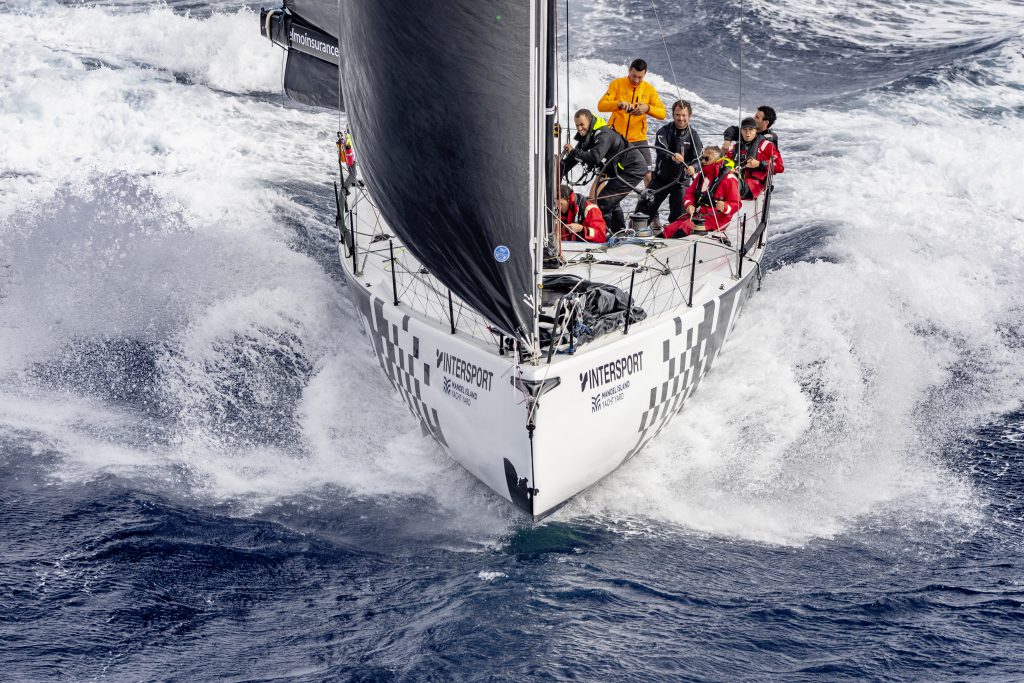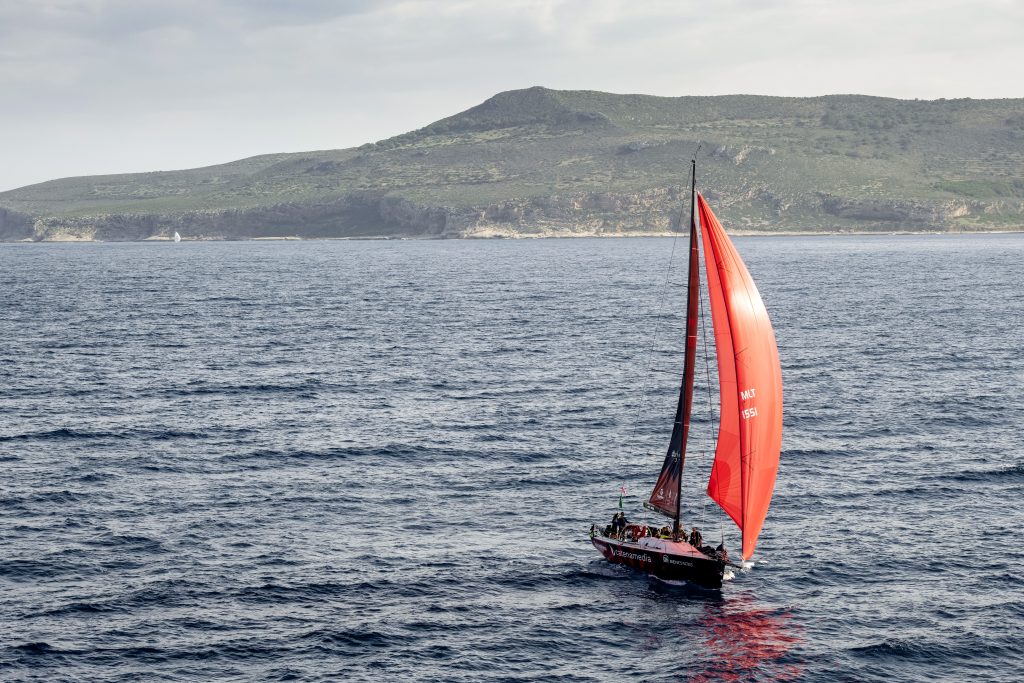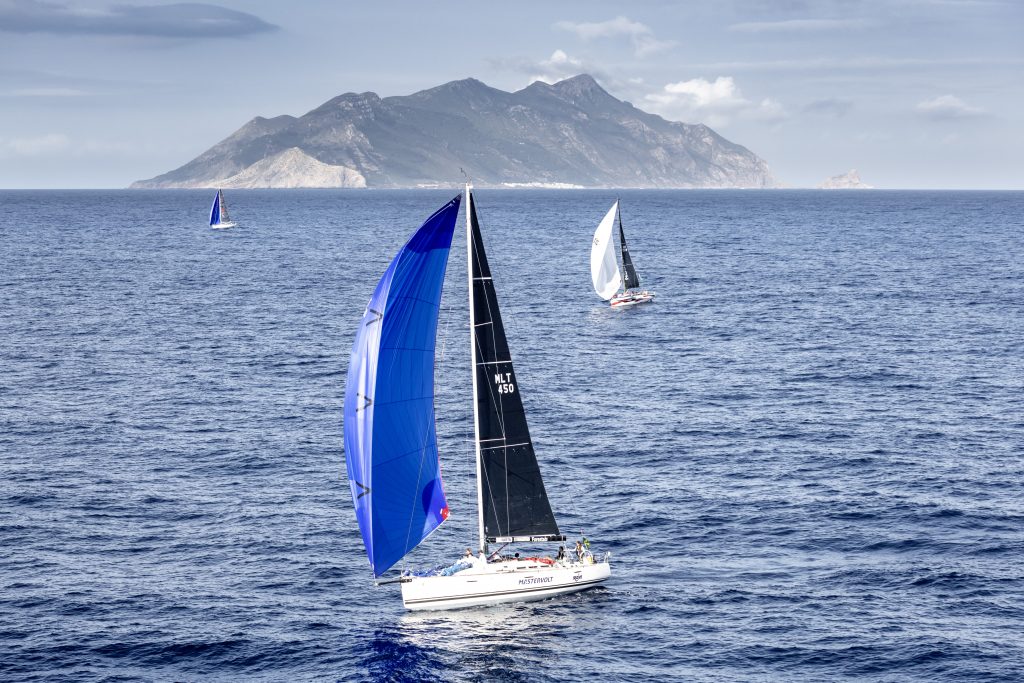
The open space outside the City Gate entrance to Malta’s capital city, Valletta, is dominated by a fountain comprising three bronze figures of mythological Tritons. Inspired by the Fontana delle Tartarughe in Rome, they represent Malta’s links with the sea, their posture gives a sense of potency.
After this year’s Rolex Middle Sea Race, the tritons could easily be replaced by Maltese sailors, whose affinity with the waters that surround their island home and whose strength in the face of extraordinary conditions, have been unquestionable this past week.
The accounts of their experiences over course of the race have elevated the stock and reputation of an already proud seafaring nation.
The HH42 Artie III, jointly skippered by Lee Satariano (15 races) and Christian Ripard (31 races), was the first Maltese boat to finish on the water.
Provisionally lying in seventh place overall, second in IRC Class Three, behind another HH42 Ino XXX, and the best Maltese entry under IRC Time Correction by some margin, the team was highly satisfied with their result.

“We knew from the forecast it was going to be fast, so our preparation took this into account,” advised Satariano.
“We adapted our watch system to ensure the drivers and tactician were kept fresh. Once or twice from Stromboli (to Trapani) we were on the limit, broaching more than once. We were prepared for these moments and kept the boat intact.”
The current Artie project began in 2019 and the team has been steadily developing the boat from an inshore racer to a capable offshore steed.
“We had been waiting for a race like this,” continued Satariano. “One that would fully test the boat and the crew. Our best points of sail are reaching and running, and the race delivered this. It was spectacular how the boat and crew responded to the tough conditions keeping on the tight rope between going fast under control and suffering damage that puts you out of the race.”
Christian Ripard has seen it all before and more.
“It was great fun, good conditions, good boat, good crew. It was definitely the fastest race I have done on this size of boat,” he commented, before adding, “it was a constant balance between seamanship and going fast. During the day was one thing, but at night the conditions were much worse. You don’t want to wipe out with a big kite (spinnaker) up going 25 knots in the dark.”

Sebastian Ripard is the grandson of John Ripard Sr, winner of the first race in 1968, and was a winner himself on his first race with his father on the J/109 Market Wizard in 2002.
Skippering the J/99 Calypso was a memorable experience.
“It was a once on a lifetime forecast with that tight low pressure over the racetrack creating mainly downwind conditions,” explained Ripard.
“From Stromboli to San Vito lo Capo we had anything from 30 to 50 knots and five to eight metre waves.”
A nice entry into and exit from the Messina Strait was a highlight, with positive current most of the way and a back eddy on the Sicilian shore for the final part. It was not all simple. Their sail inventory resulted in a difficult situation at Stromboli.
“We tried the A4 in about 30 knots, but the wind quickly picked up to late 30s, early 40s and the boat was unbelievably out of control, either broaching out or trying to scream into a Chinese gybe,” described Ripard.
“Fortunately, we got it down unscathed. It would have been easier with a smaller kite” This was Ripard’s 15th race and out of the seven crew, six were family. Calypso finished fourth in IRC Class 6 and 16th overall.
In order to win an offshore race, first you must win your class.
The Beneteau 45 Elusive 2, led by the Podesta siblings, did just that, finishing at the top of IRC Class 4. The winners of the past two races were unable to convert that success to a third win overall.
“It was extremely challenging and non-stop. There are always things you can do differently, but we were undone by the park up at Favignana on Monday. Boats behind caught up and boats in front extended,” said Christoph (20 races), of Elusive’s 22nd place overall.
Aaron (20 races) picked out some exhilarating moments that also served to emphasise the skill and knowledge of the crew who returned undamaged:
“For our type of boat, hitting 22 knots of boat speed and jumping from wave to wave was insane. Constant breeze of 30 plus knots and puffs of 37 with a kite up, we were on the limit all the time.”

Maya, the third triton in the indomitable crew, has done 21 races.
Next in order of overall results – 28th overall/8th in IRC 6 – was the double-handed Reflex 38 Vivace, sailed by Andrew Agius Delicata (8 races) and Matthew Gabriele (5), racing two-handed for the second time.
“We are very good friends, and we have complete trust in each other whatever the conditions,” explains Delicata.
Gabriele was quick to identify the strong winds of the first couple of days as one of the biggest challenges: “Even after the second day we were quite exhausted. The fact that we have been sailing together most of our lives was a big support. We knew the capability of our boat and it really helped us push through.”
Vivace finished 3rd in the Double-Handed Class.
Jonathan Gambin (14 races) sailing the Dufour 44 Ton Ton Laferla has an unbroken run of participation since 2008.
“This year was very different to previous races because there was wind all the way round,” he commented. The overall result was a disappointment following last year’s third place, and it was an up and down race.
“We had bad first leg and could not get the boat trimmed properly,” Gambin explained. “Through Messina was better, with good current and wind. We did not hoist our spinnaker on the heavy downwind section to San Vito Lo Capo. Then a good leg to Pantelleria was followed by a disastrous one to Lampedusa, where we lost our best spinnaker, knocked down by a squall.” (44th overall/4th in IRC 4).
The J/109 JYS Jan (45th/12th in IRC 6) was sailed by a young crew under the guidance of Matthew Farrugia.
“The crew was a mix of very good dinghy sailors aged 16 to 18,” he explained. “Half had experience of this race and half were new to offshore sailing.”
Of the many highlights, Farrugia was most impressed by their attitude in the face of a very difficult set of conditions.
“They knew what was coming and were absolutely the driving force,” he said. “They showed infinite energy reserves, but also good decision-making. The first night was very tough with over 30 knots from the north-east. At the end close to Malta, visibility was so bad in driving rain we could not even see the instrument panel on the mast.”
JYS Jarhead, another young crew, finished 72nd overall and 17th in IRC 6.
Jonathan Camilleri Bowman, owner of the First 40.7 OpenpaydSekuritance Maltese Falcon 2 (49th/14th in IRC 6) and on his fifth race, felt it had been challenging both mentally and physically.
“We were always pushing the boundary between speed and safety,” Bowman advised.
“The hardest part was definitely the first night when were struck by a gust of 46 knots and huge side swells. Overall, though, I will remember the way the team pulled together and got on.”
Finishing his 22nd race, Ramon Sant Hill, skipper of Farr 45 Ben Estates Comanche Raider III (61st/7th in IRC 3), described the scene below deck: “It is a race boat. We have water inside, sails to wash and the mess you would expect after 10 guys have been living onboard with no opportunity to tidy up during the race. It’s normal!”
Every race, the highlight for Sant Hill is often the same. It is the way the crew grows up: “We are a family onboard. Every year we learn to trust more in each other and the boat. We are amateurs and invest a huge amount of time and effort in the race. Getting to the start line and finishing the race is a real achievement.”
Royal Malta Yacht Club’s Rear Commodore House, Mario Debono, was on his fifth race and is representative of the Corinthian spirit of the race.
He openly admits that his Sun Odyssey 45 Janissah (71st / 16th in IRC 6) is a cruising boat with little chance of doing well in class or the overall standings.
“We are very happy to have finished this race in good shape,” Debono said.
“I would like other less competitive boats to see that, if you are a good sailor, you can do this race even if your boat is not a racer. It is a real experience, a personal challenge and extremely rewarding.”
Janissah suffered in the strong winds and rain of the first night, and then again on the last leg sailing upwind into the full brunt of the storm.
“We were completely underwater at times, and it was worse than the 2007 race. It was, though, a magnificent race and I am proud we took on everything the Med had to throw at us and came through it.”
Three other Maltese yachts took part but were forced to retire: Sean Borg’s Xp44 Xpresso, Aaron Gatt Floridia’s ICE 52 Otra Vez and Paul Debono’s Elan 410 Bait.
The Tritons Fountain was created in 1952 by the sculptor Chevalier Vincent Apap and the draughtsman Victor Anastasi. Their design was drawn from Greek mythology. Were it being conceived today, inspiration could clearly be found much closer to home.

World Cup News
-


FIFA World Cup
/ 7 days agoUruguay end winless run with dramatic late win over Colombia
Manuel Ugarte grabbed a dramatic last-gasp winner as Uruguay ended a five-match winless streak...
By AFP -


FIFA World Cup
/ 1 week agoArgentina fall in Paraguay, Brazil held in Venezuela
World champions Argentina suffered a 2-1 defeat to Paraguay while rivals Brazil were held...
By AFP -


FIFA World Cup
/ 1 month agoLenovo become FIFA’s World Cup ‘technology partner’
Chinese technology company Lenovo have signed a sponsorship deal with FIFA that covers the...
By AFP -


FIFA World Cup
/ 3 months agoVinicius says Spain should lose 2030 World Cup unless racism declines
Brazilian striker Vinicius Junior has called for Spain to be stripped of its 2030...
By AFP







































